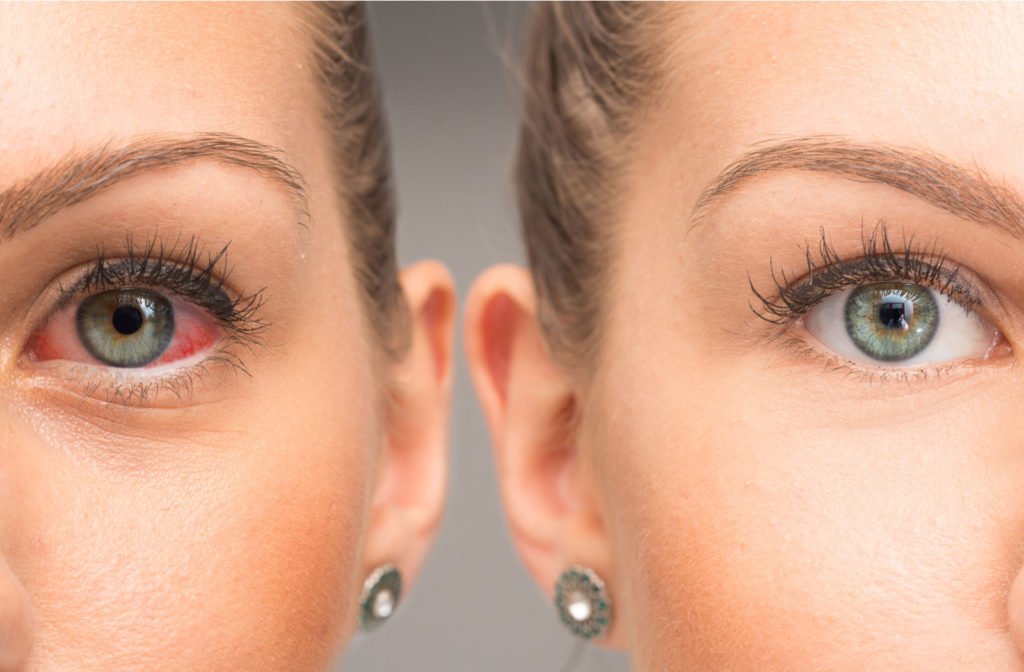What is Dry Eye?
Dry eye can be an uncomfortable and debilitating condition that, if left untreated, can lead to significant permanent damage to your eyes. Dry eye often occurs due to a lack of production of good quality tears, causing the eye to feel gritty and dry.
If you have unusually red eyes coupled with a burning, stinging sensation or eyes that feel dry and gritty, you may be experiencing symptoms of dry eye. Various external factors, such as air conditioning or recycled air, like that in an airplane, can exacerbate these symptoms significantly.
Dry eye can also manifest symptoms in less common ways, such as sensitivity to light, increased production of mucus, or overly watery eyes. If these symptoms occur for a prolonged period, it may be time to visit your optometrist for a professional opinion.
Common Causes of Dry Eye
Several things can cause dry eye, so it is important to be aware of your eye health to best pinpoint early signs. Lifestyle changes and other external factors can cause symptoms of dry eye to worsen, so keeping track of your daily routine can help to narrow down specific stressors.
Ageing
Unfortunately, ageing is a natural process in life that can cause your ocular health to worsen. Dry eye is no exception, as people over 50 tend to experience dry eye more often as tear production declines.
Although there is no cure for dry eye associated with ageing, there are certain products that can help relieve symptoms and provide extra lubrication for your eyes. Visit your optometrist for the best recommendation for you.
Computer Use
As digital devices become more widely integrated into our daily lives, more people are experiencing symptoms of digital eye strain. Symptoms can include tension headaches, eyestrain, and dry, irritated eyes.
People that work on a computer tend to blink 66% less during use, which helps to stimulate tear production to lubricate the eyes. If you are experiencing dry eye due to your digital device use, consult your optometrist for effective treatment options.
Autoimmune Disease
Certain diseases and conditions can cause dry eye symptoms, such as Sjögren’s syndrome, arthritis, and diabetes can cause reduced tear production. Although treatment of the underlying condition may improve your dry eye symptoms, specific treatment may be necessary to relieve your dry eye symptoms.
The best way to determine appropriate treatment options is to consult your optometrist at your earliest convenience.
Blepharitis
Blepharitis is a common condition that affects the eyelids, causing them to become inflamed and irritated. The oil glands behind the eyelashes become inflamed, making it difficult for oils to flow freely. The glands can become plugged and infected, creating painful, swollen eyelids and loss of eyelashes.
The oil secreted from the glands behind the eyelashes creates the outermost layer of tears, which stops them from evaporating too quickly. A lack of these oils can create poor quality tears, resulting in dry eye symptoms.
Your optometrist can diagnose this condition best and provide you with adequate treatment options, so if you suspect you have blepharitis – visit them for an appointment.
Effective Treatment Methods
There are plenty of over-the-counter and prescription medications that can relieve symptoms of dry eye. Your optometrist will be able to tailor a treatment plan best suited for your eyes, so if you are experiencing symptoms, please visit them for an appointment.
BlephEx
BlephEx is an eyelid cleaning procedure used by optometrists to help maintain clean and healthy lids. The procedure removes excess bacteria, biofilm, and toxins that are the leading cause of eyelid symptoms.
Your optometrist will be able to administer this treatment for you quickly and with minimal discomfort.
Prescription Drops
Although over-the-counter eye drops can help temporarily relieve dry eye symptoms, prescription drops may be more effective for an extended amount of time.
For example, Xiidra is a type of prescription eye drop that blocks a specific protein that may cause your eyes to not produce enough good quality tears for adequate lubrication. Your optometrist will be able to prescribe this medication for you if necessary.
Additionally, Restasis is another brand that can help treat the root causes of dry eye rather than act as external lubrication for the eye.
Punctal Plugs
If insufficient tear production or rapid tear evaporation is the cause of your dry eye symptoms, punctal plugs may be a good option for treatment. They are tiny inserts that are placed inside your tear ducts to prevent your tears from draining, keeping your eyes moist for longer.
If you suspect your symptoms are conducive to chronic dry eye, please visit your optometrist for a comprehensive eye examination. A professional opinion can help you discover the root cause of your symptoms and the best treatment for your needs.



